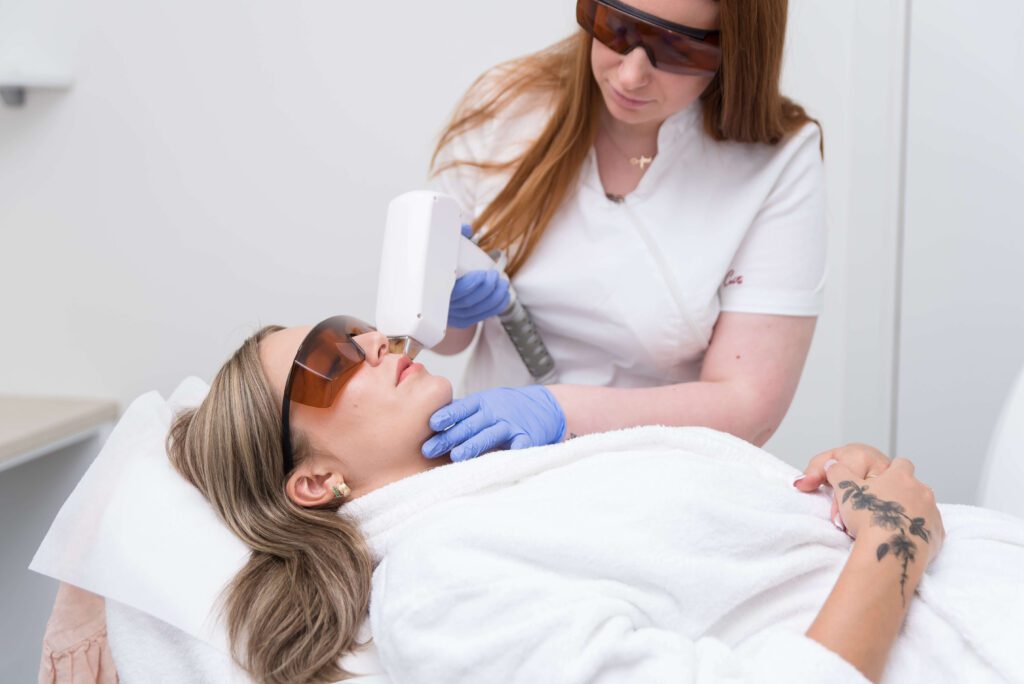Permanent Hair Removal
Every woman’s dream is to have smooth legs and arms and to permanently get rid of unwanted hair from all parts of the body. With the advancement of laser technology, this is very much possible today. Clients who have experienced it often say their life has become much simpler as they don’t have to worry about frequent waxing appointments. They can expose their body and face anytime, enjoying the smoothness of the skin without irritations and ingrown hairs that sometimes remain after waxing.
Indeed, once you get rid of persistent hairs, you realize you’ve done a long-term favor for yourself. The diode laser is the latest technology for painless and safe hair removal suitable for all skin types. It uses an optimal wavelength of 808 nm for hair removal and penetrates deeply into the dermis where the hair follicle is located.

During the treatment process, a series of photons is converted into thermal energy using the principle of selective absorption. Specifically, the hair’s chromophore (melanin) recognizes the laser’s wavelength and absorbs it directly into the follicle. The light energy is converted into heat, which coagulates the follicle, preventing future hair growth. The diode laser can remove hair from any part of the body, and treatments can be performed throughout the year. Unlike the IPL system, the diode laser treatment is faster, safer, more successful, and painless.
Treatment
Depending on the area, hairs must not be waxed or plucked with tweezers for 15-30 days before the treatment. They can be shaved as desired. Intensive sunbathing and tanning beds are prohibited a week before the treatment. It’s recommended to shave the area the day before the scheduled appointment. We use two types of lasers, diode (808 nm) and Nd-Yag laser (1064 nm). When using the diode laser on the desired treatment area, an ultrasound gel is applied. The diode laser is passed several times over the same area, while with the Nd-Yag laser, it’s passed only once. During treatment, a mild warmth is felt, and in sensitive areas (upper lip, chin, bikini) the warmth can be more intense with a slight stinging sensation. The diode laser probe cools the skin throughout the treatment, making it much more comfortable. The duration of the treatment depends on the area we wish to treat. Multiple zones can be treated during the same visit. 6-8 treatments are required, spaced a month apart, as hairs go through their growth cycle over a specific period. Only in the anagen phase (active hair growth phase) can we permanently remove the hair, as we destroy its root cell in this phase.
Candidates
People with black, brown, and light brown hair are suitable candidates. Those with very light or gray hair are not good candidates because the hair lacks enough melanin, the pigment that gives hair its color and absorbs the laser light.
The best candidates are people with black, thicker hair and light skin. The treatment is contraindicated for individuals suffering from epilepsy, photosensitive individuals, those with skin diseases in the area they wish to treat, and pregnant women. Pubescent children, PCOS (polycystic ovary syndrome), and a disturbed balance of sex hormones are relative contraindications for treatment because the results might be poorer, and the number of treatments in such cases is unpredictable.
Results
After treatment, hair growth is slightly slowed down. Hairs with a destroyed follicle fall out 2 to 3 weeks after the treatment. These are hairs from the active growth phase (anagen phase). One must also consider hairs in the catagen (resting phase) and telogen phase (hair shedding phase) because a new hair follicle may be developing beneath them, from which hair will subsequently grow. This is precisely why multiple treatments are necessary. The goal is to destroy all hairs in the active growth phase, as only then have we permanently removed them.
With each treatment, the number of permanently removed hairs will increase. 6-8 treatments over a period of 6-8 months are usually sufficient for the majority of hairs (90%) to complete their cycle. Any remaining hairs are typically very thin and light, so after the treatment cycle, a control check is recommended after 3 and 6 months.
Recovery
After laser treatment, the area may be slightly red, which usually fades within a few hours, most often an hour or two. It’s necessary to apply a high protection factor and protect the area from strong sunlight. Our recommendation is Juliette Armand Sun Film 30 or 50+ for protection from the entire spectrum of harmful radiation; it also contains antioxidants that further protect and regenerate the skin. It’s advised to avoid sun and sauna visits for a week after the treatment.
Between laser treatments, hairs can be shaved or shortened as needed, but they must not be waxed or plucked with tweezers. When undergoing treatment, the hair needs to be on the skin’s surface for the laser to detect it.